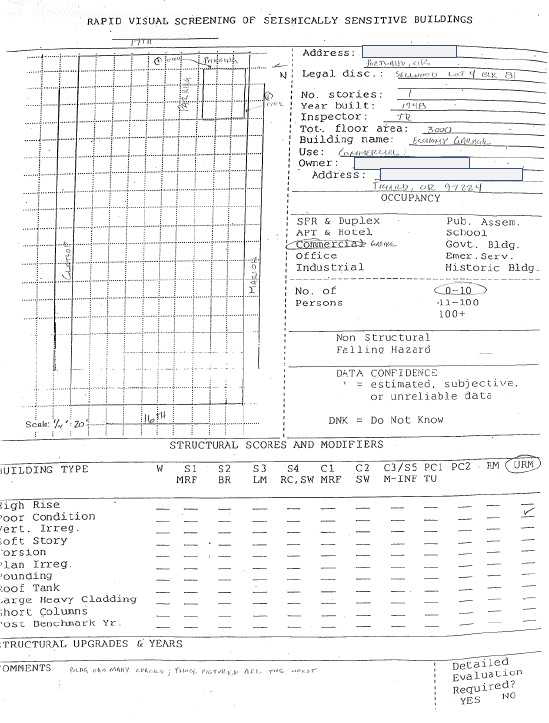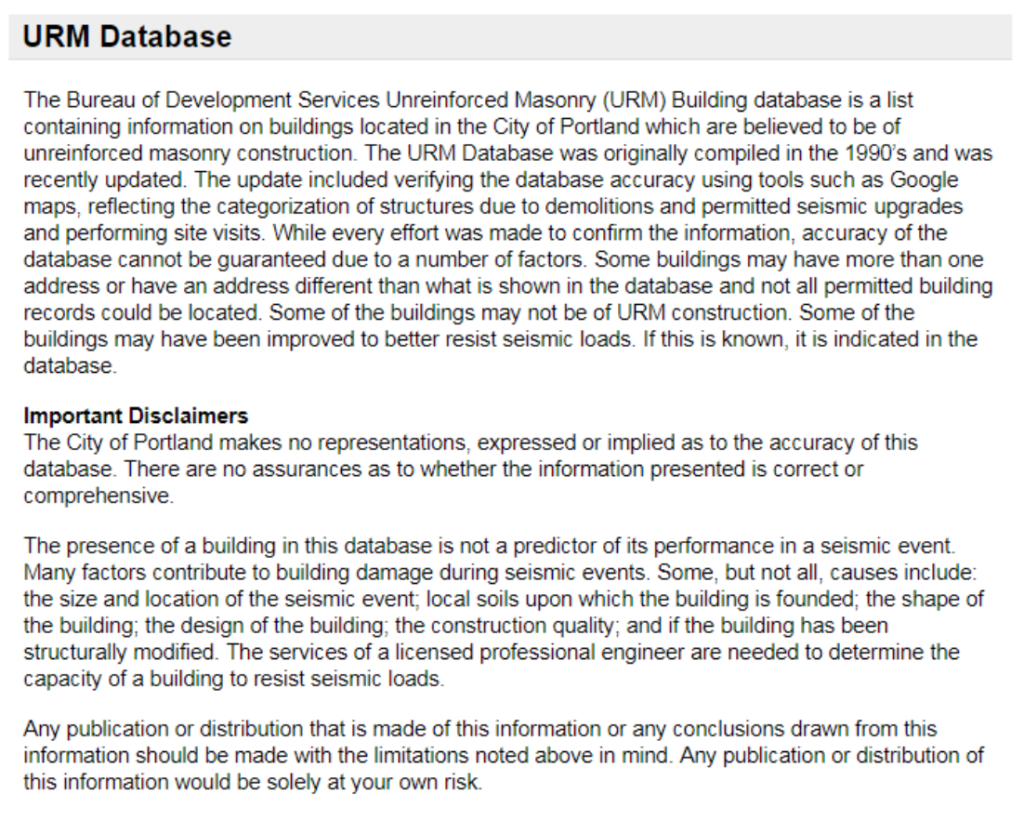Portland’s city council is starting to rethink the URM Ordinance. Led by Commissioner Hardesty, the council will consider amending the ordinance to delay its implementation and remove the deed encumbrance requirements.
However, the proposed amendment will still require buildings on the city’s “URM list” to display DANGEROUS BUILDING placards.
The problem is that the city’s URM list is inaccurate and unreliable. It is “garbage data”. Evidence in an ongoing lawsuit has revealed how the city built its list. Starting in 1990, Portland State University students were asked to do “drive-by” or “windshield” surveys of buildings. The students filled out a one-page “Rapid Visual Screening” form; here’s an example.

The students had minimal training – one participant called it “cursory”. They didn’t go inside the buildings. They didn’t do any inspection to see if it was indeed “unreinforced masonry”.
Testimony in the lawsuit showed that when the students didn’t know if a building was a URM, they put it on the list anyway. Later “updating” of the list was merely done with “Google maps”: just looking to see if the building was still there.
The URM list was simply a preliminary screening. The city admits the list is unreliable and not to be relied on. Here’s what the city’s website says:

Yet the URM Ordinance, and even the proposed amendment, still relies on this unreliable list to declare some buildings dangerous while ignoring others.
One Portland neighborhood that has many buildings on the list (Irvington), did a careful review of its listed URMs. They found:
- Half of the buildings on the URM list are not unreinforced masonry at all.
- Half of the actual unreinforced masonry buildings in the neighborhood are not on the URM list.
- 70% of the buildings on the URM list are only one story tall, and thus present little risk even if they are in fact unreinforced masonry.
Irvington has now joined the coalition opposing the URM Ordinance.
This is not how “The City That Works” should work. The city council should entirely repeal the URM Ordinance, then start a new process of citizen engagement that specifically includes lower-income households, renters, communities of color, small businesses, small building owners – as full participants, not just spectators or outsiders to be ignored.
As Commissioner Fish said, to the Portland Tribune:
“I do not support placards, or any new mandate, until we have an agreement on a comprehensive solution to the problem. And that has to include incentives to help offset the costs for small property owners,”
“We are at risk of promoting demolition through government mandate, which I do not support”
As Restore Oregon, our state’s leading organization for preserving and reusing historic buildings, stated in January:
“We join in the call for the city’s URM discussion to engage with all impacted community members to seek an inclusive, transparent, practical and fair solution with broad community and financial support.”
“Portland’s older masonry buildings are an important part of the cultural and architectural fabric of our city, and the communities and neighborhoods that depend on these buildings as places to work, perform, worship and live affordably. They are cornerstones of our community.”
“We believe that the right URM solution is positive, not punitive, and must combine appropriate seismic upgrades over a practical timeframe with robust and accessible financial assistance. It must promote preservation, not demolition, so these buildings can continue to serve all of Portland’s communities. It must not force the abandonment, and sale of these buildings or the displacement and dispossession of Portland’s vulnerable communities who rely upon them.”
Read more about the URM issue at the NW Examiner.
On February 20, starting at 10 am in front of City Hall, the coalition led by the Portland NAACP will hold a rally urging council to do the right thing when it votes later that day.